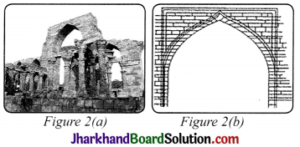JAC Board Class 7 Social Science Notes History Chapter 5 Rulers and Buildings
→ Kings and their officers built two kinds of structures between the eighth and the eighteenth centuries: the first were forts, palaces and tombs which were safe, protected and the second were structures meant for public activity including temples, mosques, tanks, wells, caravan, sarais and bazaars. From the eighteenth century only, domestic architecture like large mansions (havelis) of merchants has survived.
→ Engineering Skills and Construction:
- Buildings and monuments provide a deep understanding of the technologies used for construction.
- Architects started adding more rooms, doors and windows to buildings between the seventh and tenth centuries.
- The trabeate or corbelled style was used in the construction of temples, mosques, tombs and in buildings attached to large stepped-wells (baolis) between the eighth and thirteenth centuries.
- From the twelfth century, two technological and stylistic developments are visible. First is the weight of the superstructure above the doors and windows was sometimes carried by arches. This architectural form was called “arcuate”. Second is, the use of Limestone cement increased in construction.
- The temples were decorated with detailed carved structures and had shikhara as well in the early eleventh century.
![]()
→ Building Temples, Mosques and Tanks
As temples and mosques were the places of worship hence they were beautifully constructed. They also exhibit the pow’er, wealth and devotion of the patron.

- Kings constructed all the largest temples. These depicted the”picture of the world they rule. On the other hand, the other lesser deities in the temples were gods and goddesses of the allies and subordinates of the ruler. The temple w’as a miniature model of the world ruled by the king and his allies.
- There were people who did not claim to be incarnations of god and they were Muslim Sultans and Padshahs but Persian court chronicles described the Sultan as the “Shadow of God”.
Rulers got the chance to proclaim their close relationship with God by constructing the places of worship which was important in an age of rapid political change. Rulers also offered encouragement and support to the learned and pious people. - Sultan Iltutmish constructed a large reservoir just outside Dehli-i Kuhna called as the Hauz-i Sultani or the “King’s Reservoir” for which he acclaimed lots of respect universally.
→ Why were Temples Targeted?
- Temples were built by the kings to demonstrate their devotion to God and their power and wealth, hence they attacked on one another’s kingdoms and looted the temples.
- In the early ninth century, the Pandyan king Shrimara Shrivallabha invaded Sri Lanka and defeated the king, Sena I (831-851) and seized the Buddha monasteries and all the jewels. This blowed the pride of them.
- In the early eleventh century, when the Chola King Rajendra I built a Shiva temple in his capital. He filled it with prized statues of gods and goddesses seized from defeated rulers.
- Sultan Mahmud of Ghazni destroyed the temples during war as the one he did was Somnath temple which was attacked many times and sacked the temple as he tried to win credit and accolades. Even Portuguese attacked the temples and mosques in 1546.
→ Gardens, Tombs and Forts:
- Architecture became more complex under the Mughals. Babur was interested in planning and laying out formal gardens which were placed within rectangular walled enclosures and divided into four quarters by artificial channels called as Chahar Bagh.
- During Akbar’s reign, many important architectural innovations happened. One of the important aspects of Mughal architecture which was first visible in Humayun’s tomb was the central towering dome and the tall gateway (pishtaq).
- During Shah Jahan’s reign, we observe a huge amount of construction activity especially in Agra and Delhi. The ceremonial halls were carefully planned for public and private audience (diwan-i khas or diwan-i aam). These courts were also described as chihil sutnn or forty-pillared halls, placed within a large courtyard.
- The Chahar Bagh garden was also known as the “river-front garden”. The Taj Mahal, the greatest architectural accomplishment of Shah Jahan’s reign also adapted the river-front garden.
- He developed this form of architecture as a means to control the access that people had to the Yamuna river.
![]()
→ Region and Empire:
- Between the eighth and eighteenth centuries there was also a considerable sharing of ideas across regions due to increased construction activities, the traditions of one region were adopted by another.
- The local rulers in Bengal had developed a roof that was designed to resemble a thatched hut. This “Bangla dome” was liked by the Mughals very much that they used it in their architecture. The impact of other regions was also evident. In Akbar’s capital at Fatehpur Sikri many of the buildings used the architectural styles of Gujarat and Malwa.